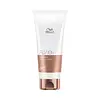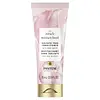What's inside
What's inside
 Benefits
Benefits

 Concerns
Concerns

 Ingredients Side-by-side
Ingredients Side-by-side

Water
Skin ConditioningStearyl Alcohol
EmollientBehentrimonium Chloride
PreservativeCetyl Alcohol
EmollientParfum
MaskingIsopropyl Alcohol
SolventPhenoxyethanol
PreservativeMethylparaben
PreservativePropylparaben
PreservativeDisodium EDTA
Propylene Glycol
HumectantQuaternium-80
Hexyl Cinnamal
PerfumingLinalool
PerfumingBenzyl Salicylate
PerfumingLimonene
PerfumingCitric Acid
BufferingAlpha-Isomethyl Ionone
PerfumingAlanine
MaskingGlycine
BufferingHistidine
HumectantSilk Amino Acids
HumectantSodium Benzoate
MaskingWater, Stearyl Alcohol, Behentrimonium Chloride, Cetyl Alcohol, Parfum, Isopropyl Alcohol, Phenoxyethanol, Methylparaben, Propylparaben, Disodium EDTA, Propylene Glycol, Quaternium-80, Hexyl Cinnamal, Linalool, Benzyl Salicylate, Limonene, Citric Acid, Alpha-Isomethyl Ionone, Alanine, Glycine, Histidine, Silk Amino Acids, Sodium Benzoate
Water
Skin ConditioningStearyl Alcohol
EmollientCetyl Alcohol
EmollientStearamidopropyl Dimethylamine
EmulsifyingBis-Aminopropyl Dimethicone
Parfum
MaskingBenzyl Alcohol
PerfumingDicetyldimonium Chloride
EmulsifyingGlutamic Acid
HumectantPEG-2m
Emulsion StabilisingDisodium EDTA
Panthenol
Skin ConditioningPanthenyl Ethyl Ether
Histidine
HumectantRosa Gallica Flower Extract
AstringentMethylchloroisothiazolinone
PreservativeMethylisothiazolinone
PreservativeWater, Stearyl Alcohol, Cetyl Alcohol, Stearamidopropyl Dimethylamine, Bis-Aminopropyl Dimethicone, Parfum, Benzyl Alcohol, Dicetyldimonium Chloride, Glutamic Acid, PEG-2m, Disodium EDTA, Panthenol, Panthenyl Ethyl Ether, Histidine, Rosa Gallica Flower Extract, Methylchloroisothiazolinone, Methylisothiazolinone
 Reviews
Reviews

Ingredients Explained
These ingredients are found in both products.
Ingredients higher up in an ingredient list are typically present in a larger amount.
Cetyl Alcohol is a fatty alcohol. Fatty Alcohols are most often used as an emollient or to thicken a product.
Its main roles are:
Though it has "alcohol" in the name, it is not related to denatured alcohol or ethyl alcohol.
The FDA allows products labeled "alcohol-free" to have fatty alcohols.
Learn more about Cetyl AlcoholDisodium EDTA plays a role in making products more stable by aiding other preservatives.
It is a chelating agent, meaning it neutralizes metal ions that may be found in a product.
Disodium EDTA is a salt of edetic acid and is found to be safe in cosmetic ingredients.
Learn more about Disodium EDTAHistidine is a semi-essential amino acid used by our bodies to create protein. It has humectant and skin conditioning properties.
Our bodies use histidine to create filaggrin - filaggrin is a structural protein that the skin uses in maintaining skin barrier.
One study found histidine and carnosine to be a dynamic duo for your skin:
Oral histidine has also been found to help with filaggrin-deficit skin disorders such as atopic dermatitis.
Why is it considered a semi-essential amino acid? This is because adults are able to create it but children must get it from their diet.
Learn more about HistidineParfum is a catch-all term for an ingredient or more that is used to give a scent to products.
Also called "fragrance", this ingredient can be a blend of hundreds of chemicals or plant oils. This means every product with "fragrance" or "parfum" in the ingredients list is a different mixture.
For instance, Habanolide is a proprietary trade name for a specific aroma chemical. When used as a fragrance ingredient in cosmetics, most aroma chemicals fall under the broad labeling category of “FRAGRANCE” or “PARFUM” according to EU and US regulations.
The term 'parfum' or 'fragrance' is not regulated in many countries. In many cases, it is up to the brand to define this term.
For instance, many brands choose to label themselves as "fragrance-free" because they are not using synthetic fragrances. However, their products may still contain ingredients such as essential oils that are considered a fragrance by INCI standards.
One example is Calendula flower extract. Calendula is an essential oil that still imparts a scent or 'fragrance'.
Depending on the blend, the ingredients in the mixture can cause allergies and sensitivities on the skin. Some ingredients that are known EU allergens include linalool and citronellol.
Parfum can also be used to mask or cover an unpleasant scent.
The bottom line is: not all fragrances/parfum/ingredients are created equally. If you are worried about fragrances, we recommend taking a closer look at an ingredient. And of course, we always recommend speaking with a professional.
Learn more about ParfumStearyl Alcohol is a type of fatty alcohol from stearic acid. It is a white, waxy compound used to emulsify ingredients.
Fatty Alcohols are most often used as an emollient or to thicken a product. Emollients help soothe and hydrate the skin by trapping moisture.
They are usually derived from natural fats and oils and therefore do not have the same drying or irritating effect as solvent alcohols. FDA allows products labeled "alcohol-free" to have fatty alcohols.
Learn more about Stearyl AlcoholWater. It's the most common cosmetic ingredient of all. You'll usually see it at the top of ingredient lists, meaning that it makes up the largest part of the product.
So why is it so popular? Water most often acts as a solvent - this means that it helps dissolve other ingredients into the formulation.
You'll also recognize water as that liquid we all need to stay alive. If you see this, drink a glass of water. Stay hydrated!
Learn more about Water